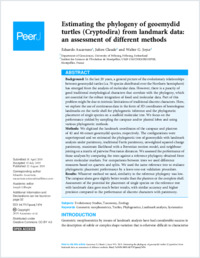Estimating the phylogeny of geoemydid turtles (Cryptodira) from landmark data: an assessment of different methods
- Ascarrunz, Eduardo Department of Geosciences, University of Fribourg, Switzerland
- Claude, Julien Institut des Sciences de l’Évolution de Montpellier, France
- Joyce, Walter G. Department of Geosciences, University of Fribourg, Switzerland
-
22.08.2019
Published in:
- PeerJ. - 2019, vol. 7, p. e7476
English
Background: In the last 20 years, a general picture of the evolutionary relationships between geoemydid turtles (ca. 70 species distributed over the Northern hemisphere) has emerged from the analysis of molecular data. However, there is a paucity of good traditional morphological characters that correlate with the phylogeny, which are essential for the robust integration of fossil and molecular data. Part of this problem might be due to intrinsic limitations of traditional discrete characters. Here, we explore the use of continuous data in the form of 3D coordinates of homologous landmarks on the turtle shell for phylogenetic inference and the phylogenetic placement of single species on a scaffold molecular tree. We focus on the performance yielded by sampling the carapace and/or plastral lobes and using various phylogenetic methods.Methods: We digitised the landmark coordinates of the carapace and plastron of 42 and 46 extant geoemydid species, respectively. The configurations were superimposed and we estimated the phylogenetic tree of geoemydids with landmark analysis under parsimony, traditional Farris parsimony, unweighted squared- change parsimony, maximum likelihood with a Brownian motion model, and neighbour-joining on a matrix of pairwise Procrustes distances. We assessed the performance of those analyses by comparing the trees against a reference phylogeny obtained from seven molecular markers. For comparisons between trees we used difference measures based on quartets and splits. We used the same reference tree to evaluate phylogenetic placement performance by a leave-one-out validation procedure.Results: Whatever method we used, similarity to the reference phylogeny was low. The carapace alone gave slightly better results than the plastron or the complete shell. Assessment of the potential for placement of single species on the reference tree with landmark data gave much better results, with similar accuracy and higher precision compared to the performance of discrete characters with parsimony.
- Faculty
- Faculté des sciences et de médecine
- Department
- Département de Géosciences
- Language
-
- English
- Classification
- Palaeontology
- Other electronic version
- License
-
License undefined
- Identifiers
-
- RERO DOC 327415
- DOI 10.7717/peerj.7476
- Persistent URL
- https://folia.unifr.ch/unifr/documents/308148
Statistics
Document views: 158
File downloads:
- pdf: 159
